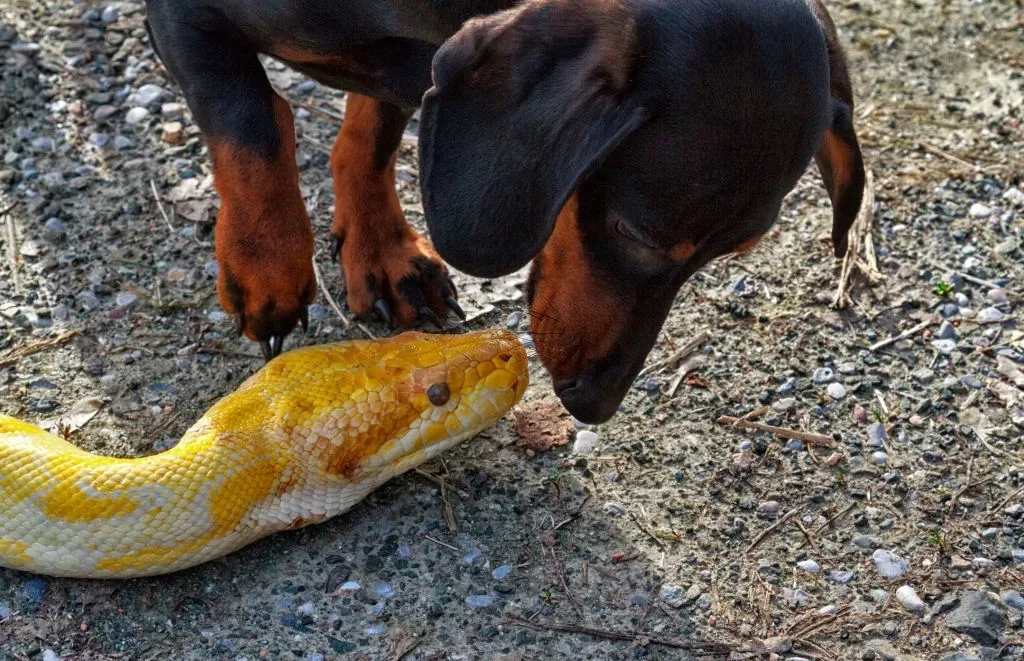Snakes are cold-blooded creatures, meaning they rely on their environment to regulate their body temperature. That’s why they’re often found basking in the sun on warm days.
Table of Contents
But snakes can also be found in a variety of other habitats, from deserts to forests to swamps to grasslands. And they’re always on the lookout for a warm place to rest, even if it means invading your home.
If you have a dog, it’s important to be aware of the dangers of snake bites. Snakes can strike quickly and without warning, and their venom can be deadly. Even if your dog survives a snake bite, they may suffer serious complications.
Why are snake bites so dangerous?
Snake venom contains a variety of toxins that can affect your dog’s body in different ways. Some toxins can damage the nervous system, causing paralysis or even death. Others can damage the blood vessels or organs, leading to bleeding, shock, or organ failure.
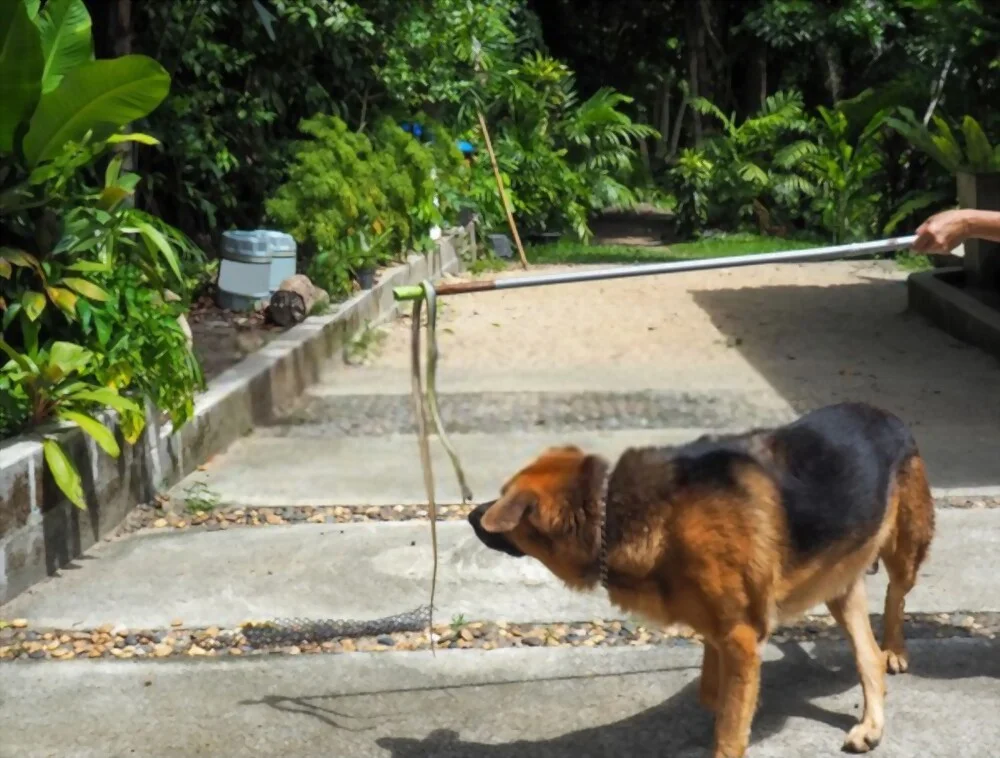
Therefore, when snakes come out for food during the warmer months, they are more likely to cross paths with naturally curious dogs, as dogs always try to chase moving objects.
Not all snakes have deadly venom, but snake bites can cause discomfort and stress to your pet.
In the case of venomous snakes, time is of the essence with regard to life-saving treatment.
If you suspect that your dog has been bitten, do not attempt life-saving measures on your own and do not delay taking him to a veterinarian.
Fatal snakebites are more common in dogs than in any other domestic animal.
Dogs that live in rural areas often encounter snakes in their open areas. When the dog is very anxious, or too tight, the dog bites, leaving the snake alone.
Snake bites can be painful and cause an infection, but a venomous snake bite can kill a puppy within an hour if you do not give first aid to the snake bite.
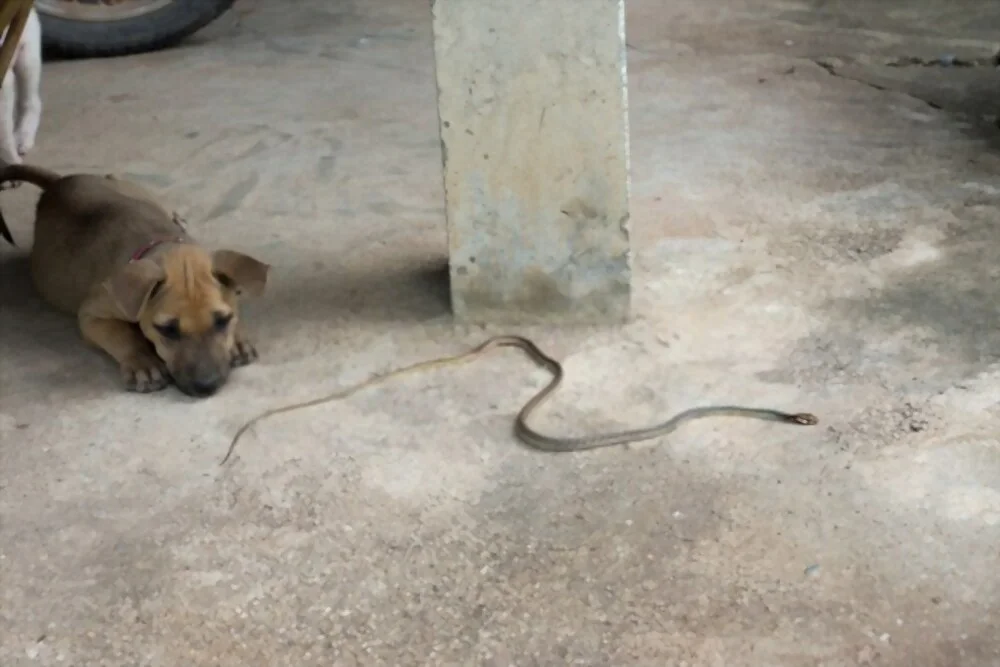
If you live in Alabama, Arizona, Florida, Georgia, South Carolina, or Texas, your puppy is at higher risk for snakebite.
Also Read: Why isn’t My Male Dog Interested in Mating?
Snake bite on dog – Symptoms
When a snake bites your dog, it might not be immediately obvious, but there are several symptoms that can develop within a short time after the bite. Here’s a closer look at these symptoms:
- Sudden and Severe Swelling: One of the most common signs of a snake bite is sudden and severe swelling at the site of the bite. This swelling can be so pronounced that it often hides the actual bite marks. So, even if you can’t see the bite wounds, the swelling is a clear indication that something is wrong.
- Tooth Marks: Non-venomous snake bites often leave behind small horseshoe-shaped tooth marks. These marks can be a helpful clue in identifying the type of snake that bit your dog. However, it’s important to remember that not all bites leave visible marks.
- Central Nervous System Effects: Some snake toxins can affect the central nervous system of your dog. This can lead to your pup appearing drunk, having seizures, or even experiencing difficulty in breathing. These symptoms can be quite alarming and require immediate medical attention.
- Gastrointestinal Distress: Snake bites can also cause gastrointestinal distress in dogs, leading to symptoms like vomiting and diarrhea. In severe cases, these symptoms can progress to convulsions, seizures, shock, and sometimes even paralysis. It’s crucial to get your dog to a vet as soon as possible if you notice these signs.
- Flesh Discoloration: Venomous snakes, like pit vipers such as copperheads, have toxins that can start digesting meat almost immediately. This can result in the flesh around the bite wound becoming discolored within minutes. This discoloration can be a telling sign of a venomous snake bite.
- Blood in Urine: Snake venom can affect the kidneys, leading to blood in your dog’s urine. If you notice discolored or bloody urine, it’s a concerning sign that requires immediate medical attention.
- Incontinence: Some toxins may impact your dog’s bladder control, leading to incontinence. Your dog might have trouble holding its urine, which can be distressing for both your pet and you as the owner.
- Mental Alterations: Snake bites can also lead to mental alterations in your dog. Your pet may appear disoriented, agitated, or exhibit unusual behaviors. These changes in mood and behavior should not be ignored.
In any case of a suspected snake bite, it’s crucial to seek prompt veterinary care. Snake bites can be life-threatening, especially if left untreated. The quicker you act, the better the chances of a successful recovery for your beloved pet.
Snake Bite on Dog Leg Pictures
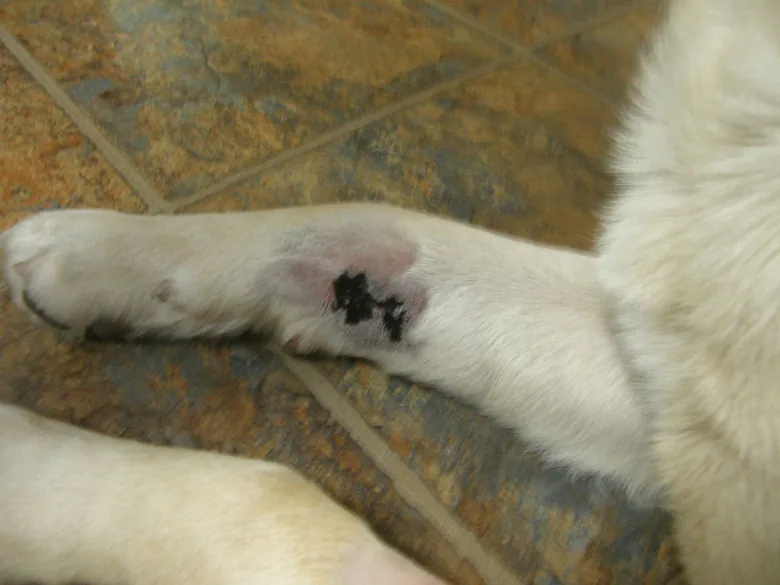
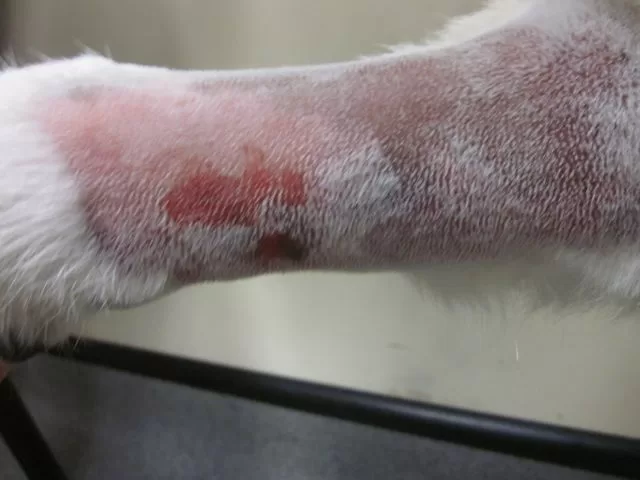
The most common species of venomous snakes are
Coral snake bite
One of the venomous snakes, the coral snake is commonly found on the southern edges of the continent. It is small with yellow, red and black circles.
It sends neurotoxic toxins, which affects the respiratory system
Rattlesnake bite on dog
Rattlesnakes are venomous snakes that are popular in North America. They are usually long and have sticky fangs.
They are hemotoxic (destroying red blood cells), anticoagulant (interrupting blood clotting), and necrotizing (causing organ degeneration and tissue damage)
Some of them inject neurotoxic toxins.
Copperhead snake bite
Copperhead snakes are venomous pit vipers that are common in the eastern and southern United States. They are typically reddish-brown in color with an hourglass marking on their body and a distinctive copper-colored head. Copperheads grow to about 2 to 4 feet in length and are often found in leaf litter, woodpiles, and other areas with dense vegetation.
Copperhead bites are relatively common in dogs, as they are curious creatures that are often attracted to snakes. Copperhead venom contains a variety of toxins that can cause a variety of symptoms in dogs, including:
- Pain and swelling at the bite site
- Bleeding
- Vomiting
- Diarrhea
- Weakness
- Lethargy
- Difficulty breathing
- Seizures
- Paralysis
If you suspect that your dog has been bitten by a copperhead snake, it is important to seek veterinary care immediately. Even if your dog is not showing any symptoms, they may still have been envenomated.
Real-life Scenario of a copperhead snake bite on a dog
In 2021, a dog named Sayner was bitten by a copperhead snake while hiking with his owner in Maryland. Sayner’s owner noticed that Sayner was yelping and limping, and she saw a snake slithering away from the area. She took Sayner to the veterinarian immediately, where he was treated with antivenom. Sayner made a full recovery from the bite.
Treatment for a Copperhead Bite
If you suspect that your dog has been bitten by a copperhead snake, it is important to seek veterinary care immediately. Even if your dog is not showing any symptoms, they may still have been envenomated.
Your veterinarian will assess your dog’s condition and determine the best course of treatment. This may include antivenom, antibiotics, pain medication, and supportive care.
Water moccasin snake bite
Water moccasins hang near streams or in swamps. They are 4 to 6 feet long and range from dark brown to black. The inside of the mouth is white, giving the snake its “Cottonmouth” nickname.
How does a snake bite look on a dog?
Evidence of bite wounds is -Pain/swelling around the bite site. Snakes often bite your pet in the face, neck, or legs when a dog tries to catch a snake.
In most cases, there may be less pain and swelling, so this is not the most reliable way to determine if your pet has been bitten – you still need to look for other signs.
Here’s a comparison chart to help you identify the differences between a poisonous snake bite and a non-poisonous snake bite on dogs:
| Characteristic | Poisonous Snake Bite | Non-Poisonous Snake Bite |
|---|---|---|
| Venomous Snake Types | Usually associated with pit vipers (e.g., rattlesnakes, copperheads) or elapids (e.g., coral snakes). | Typically non-venomous snakes, like garter snakes or gopher snakes. |
| Bite Marks | Often leaves two puncture wounds, although this can vary. | May leave small horseshoe-shaped tooth marks. |
| Swelling | Sudden and severe swelling at the bite site is common and can be extensive. | Swelling can occur but is generally less severe compared to venomous bites. |
| Pain | Intense and immediate pain at the bite site. | Pain is usually less severe than with venomous bites. |
| Flesh Discoloration | Flesh around the bite wound may become discolored quickly (within minutes to hours). | Mental alterations are less common and milder if they occur. |
| Neurological Symptoms | Central nervous system effects, such as appearing drunk, seizures, or difficulty breathing, may occur. | Neurological symptoms are less likely to occur and are usually milder, if present. |
| Gastrointestinal Symptoms | Vomiting, diarrhea, convulsions, and shock may be observed. | Gastrointestinal symptoms, if present, are generally less severe. |
| Blood in Urine | Blood in the urine (hematuria) is a possible symptom due to kidney effects. | Hematuria is less likely to occur with non-venomous snake bites. |
| Incontinence | Incontinence may result from venom affecting bladder control. | Incontinence is less likely with non-venomous snake bites. |
| Mental Alterations | Mental alterations, such as disorientation or agitation, may be evident. | Mental alterations are less common and milder, if they occur. |
| Medical Attention | Immediate veterinary care is critical. Antivenom may be necessary. | Veterinary attention is still recommended, but the urgency is generally lower. |
Remember that snake bites can vary in severity, and it’s not always easy to distinguish between poisonous and non-poisonous snake bites based solely on the initial symptoms. In any case of a snake bite, it’s essential to seek prompt veterinary care to ensure the best outcome for your dog’s recovery.
Snake bite on dogs diagnosis
- If you suspect your dog has been bitten by a snake, do not delay in taking him to the vet.
- Do not try home remedies like cold packs or tourniquets. This can cause more harm/delay in treating your beloved pet.
- If there is swelling on the face, do not touch this area together.
- Fix the part of your dog that was bitten by the snake; Try to keep this area at or below heart level.
- Try to stay calm and quiet. Do not let your dog sense that you are scared. He must be calm and courageous. Reduce his pain with your words until you reach the vet clinic.
- Do not let your pet move. The toxin spreads to other parts of his body through the moving blood.
- It is a good idea to take a picture of a dead snake or snake to help your veteran give proper treatment to the affected pet.
Treatment for snake bite on dog
- The pet affected by a snake bite should be hospitalized for at least 12 hours and ideally 24 hours.
- Although most pets usually require support and supervision, most (95%) survive with early and proper treatment.
- Antivenoms are the only proven treatment against venomous snake bites.
- The earlier it is maintained, the more effective its action will be. Normally a single bottle controls anomaly but very small doses may be required, especially in small dogs.
- IV fluid support, intensive pain management, antibiotics, and wound monitoring are required for best clinical results.
- Blood and plasma transfusions are sometimes required during acute anomalies.
There is a “snake bite vaccine” that can be used, but there are no controlled studies on its effectiveness.
The main advantage of the vaccine is that it can create protective antibodies to neutralize certain toxins injected and reduce the severity of clinical signs.
This does not mean that the vaccinated dose does not require any treatment when bitten by a snake. They still need the same treatment whether they are vaccinated or not!
Non-venomous snake bite on dog
A non-venomous snake bite is a bite from a snake that does not produce venom. Snake venom is a poison that can cause a variety of symptoms, including pain, swelling, bleeding, and paralysis. While non-venomous snake bites are not usually fatal, they can still cause serious injuries.
Symptoms of a non-venomous snake bite
The symptoms of a non-venomous snake bite can vary depending on the severity of the bite and the size of your dog. However, some common symptoms include:
- Puncture wounds at the bite site
- Swelling and pain at the bite site
- Bleeding from the bite site
- Infection
Treatment for a non-venomous snake bite
If you suspect that your dog has been bitten by a non-venomous snake, it is important to clean the wound and monitor your dog for signs of infection. If you see any signs of infection, such as redness, swelling, or discharge from the wound, you should take your dog to the veterinarian.
Tips to prevent snake bite on dog
There are a number of things you can do to prevent your dog from being bitten by a snake:
- Be aware of your surroundings when walking your dog in areas where snakes are known to be present.
- Avoid letting your dog roam free in areas with tall grass or dense vegetation.
- Keep your yard free of debris and overgrown vegetation where snakes might hide.
- Train your dog to come when called and to avoid chasing snakes or other small animals.
Do not allow your pet to explore holes or dig under rocks.
Snakes often use holes and burrows for shelter. If you allow your dog to explore holes or dig under rocks, they are more likely to encounter a snake.
Do not allow a dead snake to be tested on your pet.
Dead snakes can still be venomous. If your dog comes into contact with a dead snake, it is important to wash the area with soap and water immediately.
Monitoring your puppy is the best method, especially in areas with snakes.
If you are walking your dog in an area where snakes are known to be present, it is important to keep a close eye on them. This will help you to spot a snake before your dog does and to prevent them from being bitten.
Include your pet in rattlesnake aversion training so that they know how to recognize the scent, sound, and attention of rattlesnakes to avoid them when encountered.
Rattlesnake aversion training is a type of training that teaches dogs to avoid rattlesnakes. This training can be done by a professional trainer or at home using a rattlesnake training kit.
By following these tips, you can help to prevent your dog from being bitten by a snake.

